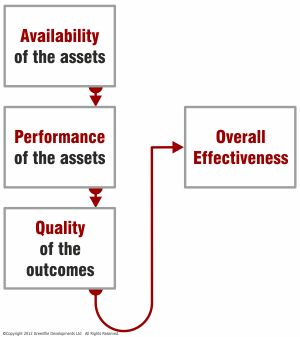productivity
Competitive advantage derives from not just from the products and services you offer but also on how they are delivered. The effectiveness of your processes and procedures can contribute to a better customer experience.
The core of an organisation is its operations. To be successful, the organisation will need to ensure that its operations are delivering value that exceeds the investment. This means there is a need to address the productivity of its assets, whether these are people, equipment or intellectual capital. It also needs to enhance the productivity of less tangible assets such as energy.
 Our approach to productivity is based on operational effectiveness: whether your assets are available to perform; what that performance is; and the quality of the outcomes.
Our approach to productivity is based on operational effectiveness: whether your assets are available to perform; what that performance is; and the quality of the outcomes.
- The necessary assets, whether people, equipment, materials, data, budget or time need to be available to deliver the outcomes.
- The assets also need to perform as designed to enable operations to take place at the designed pace.
- The quality of the outcomes need to meet the required specifications.
Since very few processes are designed to operate sub-optimally, then most investment calculations are based on getting a return from processes which we assume are "perfect". However, if any of these three parameters are not optimised or operating at a lower level than designed, then it is unlikely that the desired levels of return are going to be achieved.
Furthermore, the impacts of these three parameters multiply on each other.
For example, equipment breakdowns and staff illness meant only half the assets are there to do the work or the availability is 50%. This then limits what can be produced and if the pace of work is reduced to say 75% of the designed throughput because critical resources are not performing, then this reduced workload and slowed delivery will impact severely even on the "best possible - no defects" quality:
Availability rate (0.5) x Performance rate (0.75) x Quality rate (1) x 100 =
37.5% Overall Effectiveness
Simply put, this means for every £1, $1 or €1 you are investing in the operations, 62.5% is lost because that amount is not doing any work for you.
Now, perhaps your company is
making an acceptable profit even at 37.5% Overall Effectiveness, but think about what the profit may be at 50% or 75% Overall Effectiveness.
For a public sector organisation, an increase in Overall Effectiveness means delivering more for less - achieving both cost cutting and enhanced services at the same time.
The other aspect about having an Overall Effectiveness of less than 100% is that your overheads are still paid as though full effectiveness is being delivered. The utility companies are not going to offer you a discount just because you cannot maximising the return on your electricity or gas purchases. This is more than a hit on the cost of operations but also an extra environmental burden. A wasteful use of natural resources.
We link these issues together and use Lean and Six Sigma techniques to help companies improve their cost position, their overall effectiveness as well as their sustainability performance. Our activities in the UK construction sector is an illustration of this approach.
